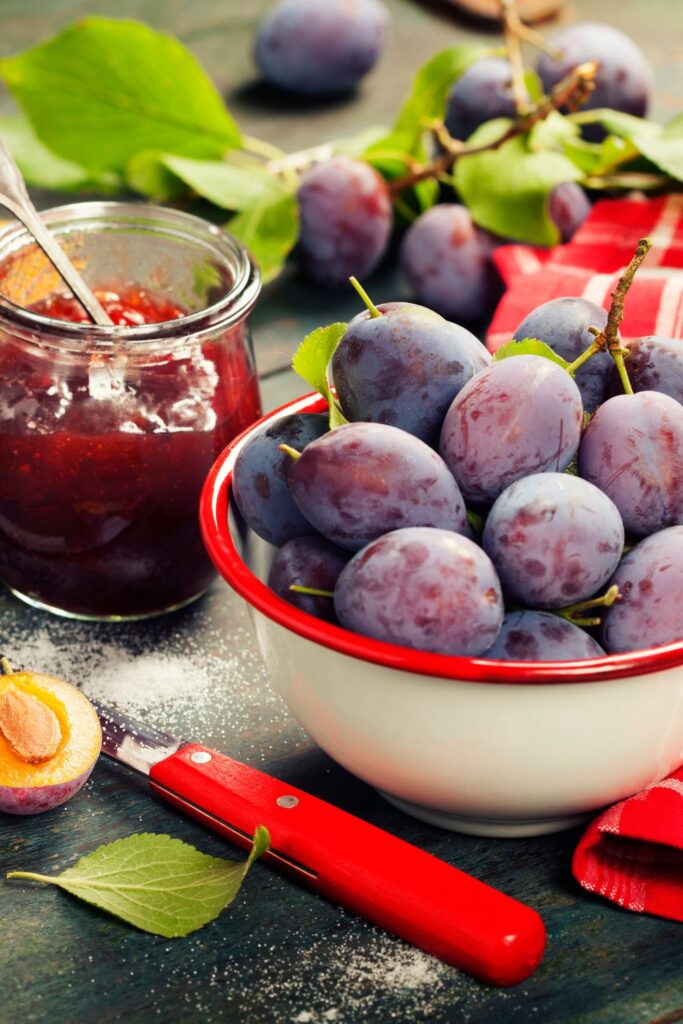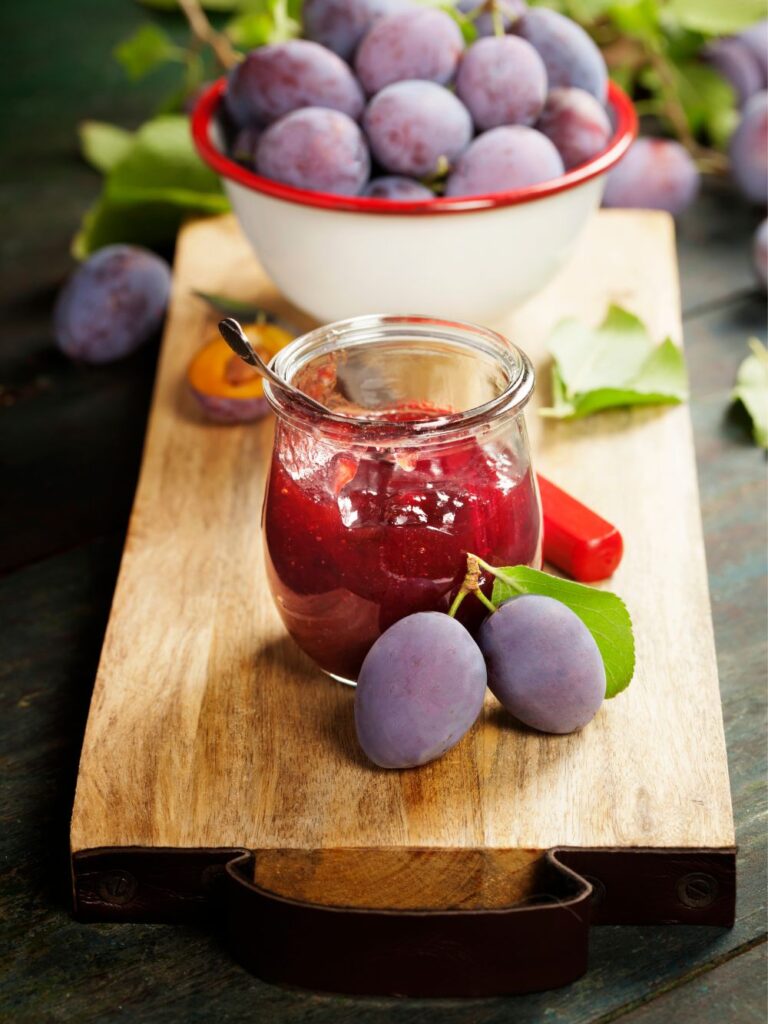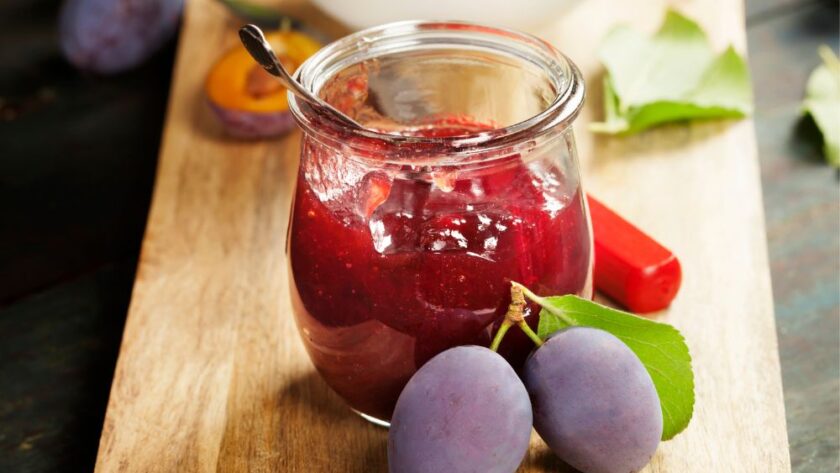Every year around late August, I find myself standing in the garden or at the market with a bowl of deep purple damsons, wondering what on earth to do with all of them. They’re not exactly the kind of fruit you eat raw — too tart for that — but turn them into jam? Oh, now we’re talking.
This damson jam is thick, glossy, and full of character. It’s got that sweet-sour balance that makes your toast taste like it came from a fancy café, even if it’s just the crusty end of a loaf you found at the back of the bread bin. The recipe is old-fashioned in the best way — no shortcuts, just proper fruit, sugar, and patience. It’s Mary Berry’s version, so you know it’ll work. And honestly, there’s nothing quite like seeing your own jars lined up on the shelf, still warm, lids popping, ready for winter.
If you’ve never made jam before, don’t panic. This one’s forgiving — the damsons are high in pectin, so it’ll set beautifully even if you slightly mess up. Which I have. More than once.
Why You’ll Love It
- Tastes like proper English countryside in a jar.
- Perfect balance of tart and sweet — not cloying.
- Uses just 3 ingredients — no additives, no weird gelling agents.
- Preserves well for months — if you can resist eating it all.
- Gorgeous with toast, scones, cheese, roast pork… anything really.
- Turns those awkward damsons into actual treasure.
Ingredients
- 1.5 kg ripe damsons (stoned after weighing)
- 1.875 kg granulated sugar
- 450 ml water
- 20 ml water to simmer with the stones
How to Make It
Gently simmer the fruit:
Pop your damsons and 450ml water into a large preserving pan. Heat slowly and let them simmer for about 20 minutes, giving them the occasional stir. They’ll start to break down into a lovely dark mush.
Extract the good stuff from the stones:
In a separate small pan, add the reserved stones and 20ml water. Simmer them gently for 20 minutes. Yes, this is a bit of a faff, but it adds flavour and pectin. Worth it.
Squeeze (but not too much):
Once the stones are soft, strain them through a clean muslin cloth or a sieve lined with cheesecloth. Don’t go full Hulk on it — just press lightly with a wooden spoon. You want clear juice and a bit of pulp, not gritty bits.
Sweeten the deal:
Add the strained juice to the damson mixture in the preserving pan, then pour in the sugar. Stir slowly over low heat until the sugar completely dissolves — you don’t want grainy jam.
Boil it like you mean it:
Turn up the heat and bring the jam to a proper rolling boil. Stir frequently (seriously, don’t wander off) and boil for about 13 minutes. Then test it for set.
Do the wrinkle test:
Spoon a little jam onto a chilled plate. Let it sit for a minute or two, then push it with your finger. If it wrinkles like a tiny edible bedsheet, it’s ready. If not, boil another 2 minutes and try again.
Jar it up:
Once it’s set, turn off the heat and carefully ladle the jam into warm, sterilised jars. Screw the lids on tightly and leave to cool. You’ll get about 2.1 litres — around 7 or 8 jars depending on size.

Common Mistakes and How to Dodge Them
My jam didn’t set.
You may not have boiled it long enough, or the damsons weren’t ripe enough. Just reboil with a squeeze of lemon juice — that usually helps.
It’s too thick and sticky.
Probably boiled too long. Next time, do the wrinkle test earlier. You want set, not cement.
Too many bits!
Damsons can be pulpy. If you like a smoother jam, strain part of it before jarring. Or don’t — rustic is charming.
It’s not sweet enough.
This is a tart jam by nature. You can bump up the sugar next time, but don’t overdo it or you’ll lose the fruit’s personality.
Storage and Reheating
Short-term:
Once open, keep a jar in the fridge. It’ll last 5–6 weeks if you don’t double-dip.
Long-term:
Store sealed jars in a cool, dark cupboard for up to a year. Label the tops — I always forget which year I made mine.
To warm up:
Pop a few spoonfuls in a saucepan over low heat if you want it soft for spreading or glazing. Or microwave it in 10-second bursts.
Frequently Asked Questions
Can I use frozen damsons?
Yep! Just thaw them first and drain off excess liquid.
Do I really need to cook the stones separately?
Technically no, but they’re packed with pectin and flavour — it’s a game-changer for texture and setting.
Can I add other fruit?
A handful of blackberries or plums won’t hurt, but too much and it’s no longer damson jam. Keep it simple the first time.
How long will it keep?
Unopened jars in a cool cupboard: 12 months easy. Opened in the fridge: 4–6 weeks.
Nutrition Facts (Per Serving – based on 1 tbsp):
- Calories: 55
- Fat: 0g
- Carbs: 14g
- Sugar: 13g
- Protein: 0g
- Fibre: 0.3g
- Sodium: 1mg
Try More Mary Berry Recipes:

Mary Berry Damson Jam
Description
A glossy, tangy, and richly fruity damson jam that captures the best of late summer in a jar — simple, traditional, and absolutely addictive.
Ingredients
Instructions
- Simmer damsons in water for 20 minutes until soft.
- Simmer stones separately with 20ml water for 20 mins, then strain.
- Add strained juice to fruit, stir in sugar, and heat gently until dissolved.
- Boil rapidly for 13 minutes, stirring often.
- Test for set using the wrinkle method.
- Pour into sterilised jars and seal. Cool completely before storing.
Notes
- Use fully ripe damsons for best flavour and set.
- Always stir during the boil to avoid burning.
- Chill a plate ahead of time for the wrinkle test.
- Don’t worry if it doesn’t set right away — you can reboil and try again.

